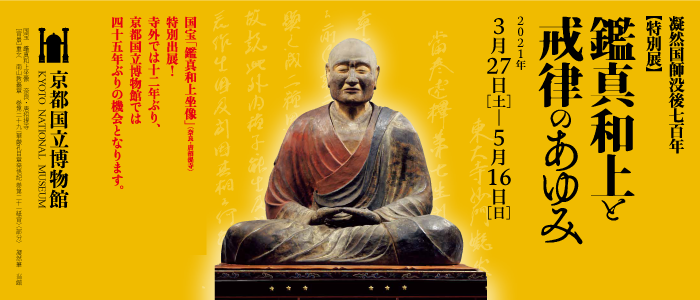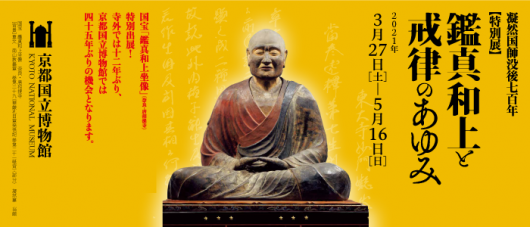Event
Priest Gyōnen 700th Memorial Special Exhibition
The Buddhist Legacy of Jianzhen (Ganjin) and His Successors
March 27 – May 16, 2021
The exhibition has two installations:
Part I: March 27 – April 18, 2021
Part II: April 20 – May 16, 2021
Some artworks may be rotated during the exhibition period.
Hours:
9:00 a.m.–5:30 p.m. (Entrance until 5:00 p.m.)
*Evening hours on Fridays and Saturdays have been cancelled.
Closed:Monday
Admission:
Adult 1,800 yen (1,600 yen)
Univ. Student 1,200 yen (1,000 yen)
High School Student 700 yen (500 yen)
Fees in parentheses are advance purchase tickets (available February 1–March 26, 2021). Please see the Special Exhibition Official Website (in Japnese).
Admission is free for junior high school students and other youths age 0–15, visitors with disabilities and one caretaker. Please show I.D.
Please show student I.D. for student admission.
Admission is reduced by 500 yen for Campus Members (including faculty) able to produce I.D.
https://www.kyohaku.go.jp/eng/special/index.html
Venue
Kyoto National Museum
http://www.kyohaku.go.jp/eng/index.html
Access: 527 Chaya-cho, Higashiyama-ku, Kyoto, 605-0931, Japan
Tel:075-525-2473
About
The eminent Tang-dynasty Chinese Buddhist priest Jianzhen (688–763), better known by his Japanese name of Ganjin, was a highly respected master of the Vinaya (Ch: Jielü) school, which is grounded in legal codes of conduct (precepts) and ordination procedures for the Buddhist clergy. Despite his prominent position in his homeland, Ganjin agreed to leave it for Japan in order to establish the Ritsu (or Risshū) school on the invitation of Yōei and Fushō, two Japanese monks dispatched by Emperor Shōmu. After making five failed attempts to cross the sea, and going blind in the meantime, Ganjin finally reached Japanese shores on his sixth trip in the year 753. Thereafter, based out of Nara’s Tōshōdai-ji Temple, he oversaw the reception in Japan of the orthodox Chinese interpretation of the Buddhist precepts, which dramatically improved the quality and legitimacy of Japanese Buddhism.
The concept of vinaya (J: kairitsu), or precepts, comprises both the rules of discipline (J: ritsu) of the monastic community and the moral and ethical standards (J: kai) that members of the clergy and laypeople should follow in their day-to-day lives. Studying the vinaya involves reassessing the meaning of Buddhism and of what it is to be a Buddhist cleric. For this reason, dedicated monks living in times of major social change have often looked back to these fundamental precepts before launching movements to reform and revitalize Japanese Buddhism. This was particularly the case during the Kamakura period, which saw the emergence of a series of brilliant priests from temples in or around the ancient capitals of Nara and Kyoto. They include Kakujō (1194–1249) of Tōshōdai-ji, Eison (1201–1290) of Saidai-ji, Shunjō (1166–1227) of Sennyū-ji, and of course Gyōnen (1240–1321) of Tōdai-ji, whose 700-year memorial is being celebrated with this exhibition. These scholar-monks gained widespread followings by engaging in social welfare projects that reflected vinaya disciplinary codes and mores. Vinaya regulations continued to remain relevant even into the relatively stable society of the early modern period through revival movements led by such notable priests as Myōnin (1576–1610) and Jiun (1718–1805).
This exhibition honors the memory of Ganjin, venerated as one of the true founders of Japanese Buddhism, with a selection of treasures preserved through the centuries at Tōshōdai-ji. These objects, together with masterworks from other temples associated with the vinaya and its revival over the ages, trace the Buddhist legacy of Ganjin and the various luminaries who emerged as his spiritual successors in Japan.






